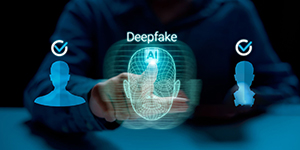AI Hiring Bias: How to Avoid Bias in Recruitment Tools
Artificial intelligence (AI) has quickly revolutionized how businesses identify, evaluate, and hire talent. From resume processing to predictive analytics, AI recruitment tools are now integrated into almost every stage of the hiring process. However, despite the efficiency and scalability these systems provide, a big concern remains: AI hiring bias.
If left unchecked, AI algorithms, can unintentionally reproduce or even amplify human biases, resulting in unfair recruiting outcomes. In the current competitive and ethically conscious job market, it is not only a moral imperative, but also a legal, and strategic one to comprehend how to ensure bias-free recruitment.
This article delves into the causes of AI bias in hiring, offers solutions to make AI recruitment tool more fair, and unbiased, and, offers practical tactics to combat this issue.
 |
Understanding AI Hiring BiasAI hiring bias occurs when artificial intelligence algorithms applied in recruitment yield unequal or discriminating results for specific populations. These biases are generally caused by skewed data, historical injustices, or poorly constructed algorithms. For example, if an AI model is trained on recruiting data that indicates gender or racial disparities it may learn to favor candidates who are similar to those who have previously been hired, perpetuating existing inequalities. |
AI recruitment methods are primarily reliant on data trends. If historical data suggests that males are more frequently promoted in a given role, the algorithm may presume men are "better fits" and rate male candidates higher. This perpetuates a loop of bias that undermines the purpose of fair hiring practices.
Common Causes of AI Hiring Bias
- Historical Data Bias occurs when training data reflects, biased previous decisions.
- Algorithmic bias occurs when the design of an algorithm unintentionally favors or disadvantages specific groups.
- Sampling bias occurs when the dataset does not accurately represent all demographics.
- Feature Bias occurs when specific criteria (such as zip codes or education) have an indirect correlation with race, gender, or socioeconomic position.
To achieve bias-free recruitment, HR leaders must understand the underlying causes and establish systems that actively monitor and correct them.
The Importance of Bias-Free Recruitment
The goal of bias-free recruitment extends beyond eliminating prejudice to building a framework for identifying and valuing talent fairly. Organizations with diverse teams consistently outperform homogeneous ones, demonstrating greater innovation and decision-making.
Bias in AI systems can harm a company's reputation, expose it to legal risks, and result in the loss of talented candidates. Ethical AI in hiring is becoming an essential component of current HR ethics and compliance.
Governments and regulatory authorities, are now prioritizing AI hiring compliance with diversity standards, requiring companies to demonstrate that their automated systems are fair and inclusive.
A hiring system without bias is good for everyone: employers can find more qualified candidates, and candidates feel like the review process is open and fair.
The Role of AI Recruitment Tool
AI recruitment solutions are intended to streamline processes, such as resume screening, skill assessment, and interview scheduling. They process enormous amounts of candidate data quickly, eliminating manual labor, and human bias.
However, if these tools are designed, or utilized incorrectly, they may unintentionally embed discriminating patterns. Thus, understanding how these tools work is critical for decreasing bias in recruiting.
Common AI uses for employment include:
- AI job screening means using computers to look over resumes and profiles and find the best matches.
- Chatbots for candidates: standardizing communication to make sure everyone gets the same care.
- Predictive analytics uses past data to figure out which candidates are most likely to win.
- Video interview analysis: figuring out things about a person's personality or communication skills by using speech or face recognition.
Each of these could be biased if they are not planned and watched carefully.
How to Prevent Bias in AI Recruitment Tools
The development of ethical AI in hiring process necessitates more than just positive intentions. It necessitates concrete policies, technologies and actions that guarantee equity. The following are how to prevent bias in AI recruitment tools.
1. Clean and Audit Training Data
The facts that AI learns from is what makes it fair. Companies need to go through their old hiring records and get rid of any discrimination trends. As part of cleaning up data, variables that might unintentionally show protected traits like race, gender, or age must be removed.
2. Employ a Wide Range of Training Datasets
A dataset that is both balanced, and diverse is essential for the AI model to accurately evaluate candidates from a variety of origins. This is one of the most effective strategies to make AI hiring fair and unbiased.
3. Conduct routine bias testing
Continuous testing of AI models should find and fix any flaws that are found. To do this, simulations must be run to see if the system's estimates, are hurting certain groups.
4. Implement human oversight.
The importance of human judgment persists, despite the existence of sophisticated AI systems. Recruiters should consistently evaluate AI-generated shortlists to guarantee, that fair hiring practices are maintained.
5. Guarantee Algorithm Transparency
It is imperative, that companies disclose the workings of their algorithms. It is beneficial for both candidates and regulators to comprehend the fairness, and, reliability of AI recruitment tool by providing an explanation of the decision-making logic.
6. Ensure that AI Hiring Complies with Legal and Diversity Standards
Organizations are required to guarantee, that AI hiring compliance with diversity standards, including the Equal Employment Opportunity Commission's (EEOC) guidelines. Not only is compliance necessary for legal protection but it also enhances corporate social responsibility.
Ethical AI in Hiring: Setting Standards
Ethical AI in hiring is a set of rules that make sure hiring people using technology is fair, private and open to everyone. It's not enough for AI to be technically correct; it also needs to be morally responsible.
The following rules should be followed by companies that are making AI tools:
- Fairness: Systems must work to stop injustice and make sure everyone has the same chances.
- Accountability: It should be clear to everyone in the company, who is responsible for the results of AI.
- Transparency: Candidates should know when AI tools are being used to judge them.
- Privacy: Personal information must be kept safe and in an honest way.
Companies that follow these rules make tools to reduce bias in automated candidate screening less biased, and build trust between candidates and hire teams.
Reducing Bias in Recruitment: Practical Strategies
Both technology and organizational culture are essential in the reducing bias in recruitment. The following strategies are actionable and contribute to the promotion of equitable outcomes.
1. Integrate AI insights with human judgment
AI is capable of processing data at a quicker pace than humans; however, humans contribute contextual understanding, and empathy. A hybrid approach guarantees that AI candidate screening does not exclude qualified candidates, on the basis of restricted criteria.
2. Implement Blind Screening Methods
Before evaluation, blind screening eliminates personally identifiable information such as names, or photographs. This promotes bias-free recruitment, by incorporating it into AI recruitment tool.
3. Establish Ethical Review Boards
A lot of forward-thinking businesses now have ethics groups that look over algorithms, and make sure that using AI for hiring in a way that is ethical and follows the law.
4. Consistently revise algorithms
AI systems must adapt to the changing needs of society and the job market. Hiring decisions are not influenced by obsolete data, or logic as a result of frequent updates. This proactive strategy facilitates the AI hiring compliance with diversity standard.
5. Conduct training sessions for human resources personnel regarding AI ethics
Recruiters and HR managers should have a comprehensive understanding of the operation of AI systems, their limitations, and how to prevent bias in AI recruitment tools through meticulous oversight. Education, ensures that technology functions as a complement, not a replacement for human fairness.
Tools to Reduce Bias in Automated Candidate Screening
Numerous contemporary solutions, are tools to reduce bias in automated candidate screening with an emphasis on transparency, and inclusivity. In addition to enhancing impartiality, these technologies also assist organizations, in achieving their compliance objectives.
- Textio is a platform that facilitates the recruitment process without prejudice by eliminating gendered or biased language from job descriptions.
- Pymetrics employs neuroscience-based games to objectively assess the cognitive and affective characteristics of candidates.
- HireVue (Ethical AI edition) – Integrated fairness auditing capabilities to monitor bias in AI candidate screening.
- Applied – Provides anonymized application screening and analytics to assess and mitigate bias throughout the entire process.
- FairHire, is a tool that is specifically engineered to verify the equity of model outputs in order to ensure that AI hiring adheres to diversity standards.
These tools can substantially reducing bias in recruitment, while maintaining efficiency and scalability when used responsibly.
Strategies to Make AI Hiring Fair and Unbiased
A combination of technology, ethics and governance is necessary to create strategies to make AI hiring fair and unbiased. The following are the fundamental strategies, that organizations should implement:
- Inclusive Algorithm Design - Guarantee that the design process involves a variety of stakeholders, who are capable of identifying potential blind spots.
- Impartiality Metrics – Incorporate quantifiable indicators of impartiality into algorithms, such as demographic parity.
- Explainability Models – Use explainable AI (XAI) to make decisions clear and easy to check.
- Ethical Partnerships – To ensure compliance and accountability, collaborate with ethical AI organizations.
- Candidate Feedback Mechanisms – Enable applicants to request feedback on AI-generated decisions, thereby enhancing trust, and impartiality.
These tactics are the most important parts of ethical AI in hiring, because they stop discrimination, increase diversity and make sure that international standards are met.
AI Hiring Compliance with Diversity Standards
The regulation of AI's use in recruitment is being facilitated by the development, of legal frameworks. For example, the European Union's AI Act and U.S. state-level laws are beginning to mandate that companies document and justify their use of AI hiring tools.
It is now an operational necessity to ensure that AI hiring compliance with diversity standard. Organizations, are required to demonstrate that their systems:
- Do not treat people differently, because of protected traits.
- Are checked for fairness, and accuracy on a daily basis.
- Include decision-making methods that can be explained and checked.
Failure to comply may result in penalties, lawsuits or reputational damage. Companies that, proactively implement bias free recruitment practices not only adhere to the law, but also acquire a competitive edge by recruiting a diverse pool of talent.
The Future of Fair Hiring Practices
Fair hiring practices, must evolve in tandem with the ongoing transformation of the workforce by AI. A partnership between human empathy, and, sophisticated AI analytics, is likely to be a component, of the future of recruitment.
The manner in which companies evaluate candidates will be revolutionized by emerging innovations such as explainable AI, impartiality dashboards, and real-time bias monitoring. In the near future, AI recruitment tool, will incorporate embedded ethical standards that automatically identify, and rectify bias prior to the implementation of decisions.
Not only will organizations enhance their brand, but they will also contribute to a more inclusive global job market by investing early in the reducing bias in recruitment and the establishment of transparent systems.
Ultimately, the future of hiring is contingent upon our shared capacity to develop ethicals AI in hiring systems that acknowledge human potential in all its manifestations, promote equity, and respect diversity.
Conclusion
AI hiring bias is not an inevitable consequence of technology; rather, it is a solvable challenge. Organizations can ensure that all candidates are treated fairly while utilizing AI's potential through a dedication to ethical standards, continuous monitoring and mindful design.
Companies can establish equitable workplaces by adhering to best practices for bias free recruitment, utilizing contemporary AI recruitment tool and implementing strategy to make AI hiring fair and unbiased.
The critical aspect is comprehending, how to prevent bias in AI recruitment tool from data collection to algorithm testing while simultaneously ensuring that AI hiring compliance with diversity standard.
Tool to reduce bias in automated candidate screening will become indispensable allies in the promotion of equitable employment practices as HR technology continues to develop. The combination of these innovations has the potential to revolutionize the hiring process, making it not only data-driven, and efficient, but also profoundly ethical and inclusive.
By adhering to these principles, we can guarantee that the potential of AI is consistent with the principles of humanity which include respect for the potential of each individual, equality, and fairness.
Read More: AI Recruitment Tools & Software for Cambodian Businesses





